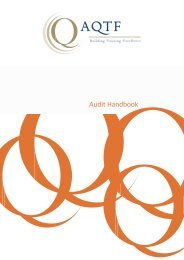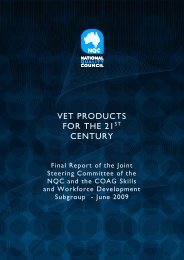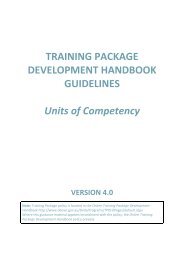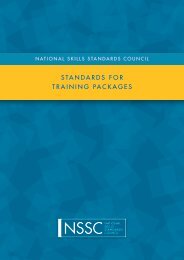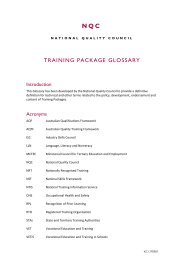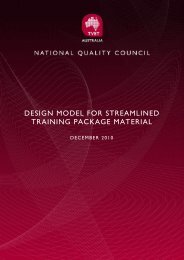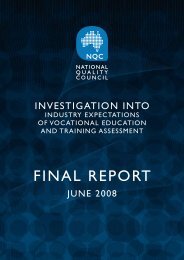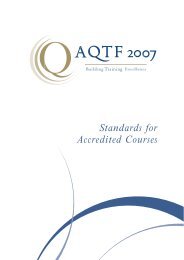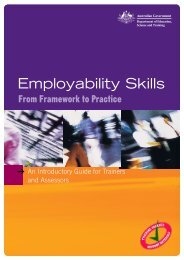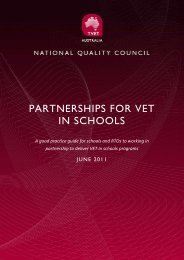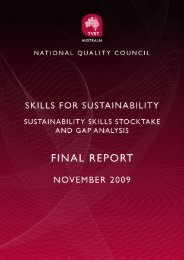Guide for Developing Assessment Tools - National Skills Standards ...
Guide for Developing Assessment Tools - National Skills Standards ...
Guide for Developing Assessment Tools - National Skills Standards ...
- No tags were found...
Create successful ePaper yourself
Turn your PDF publications into a flip-book with our unique Google optimized e-Paper software.
NQC | <strong>Guide</strong> <strong>for</strong> developing assessment toolsSamplingSampling is the process of selecting material to use in validation and/or moderation.Split half reliabilityStakeholdersStandard ReferencedFrameworksSufficiencyTarget groupTrialling of assessment toolsThresholdsUnit of CompetencyType of reliability which is concerned with the internal consistency of a test, where thecandidate sits the one test, which is subsequently split into two tests during the scoringprocess.Individuals or organisations affected by, or who may influence, the assessment outcomes.These may include candidates, assessors, employers, other RTOs etc. Each stakeholdergroup will have their own reporting needs in relation to the outcomes of the assessment.It is a subset of criterion referencing which requires the development and use of scoringrubrics that are expressed in the <strong>for</strong>m of ordered, transparent descriptions of qualityper<strong>for</strong>mance that are specific to the unit(s) of competency; underpinned by a theory oflearning; and are hierarchical and sequential. Subject matter experts unpack the unit(s) ofcompetency to develop the frameworks where levels of per<strong>for</strong>mance are defined along adevelopmental continuum of increasing proficiency and used <strong>for</strong> interpretative purposesto infer a competency decision. The developmental continuum describes the typicalpatterns of skills and knowledge displayed by individuals as they progress from novice toexpert in a specific area. Along this developmental continuum, a series of cut-points canbe made <strong>for</strong> determining grades (e.g. A, B, C or D etc) as well as the cut-point <strong>for</strong> makingcompetent/not yet competent decisions.One of the principles of assessment and also one of the rules of evidence. Sufficiencyrelates to the quality and quantity of evidence assessed. It requires collection of enoughappropriate evidence to ensure that all aspects of competency have been satisfied andthat competency can be demonstrated repeatedly. Supplementary sources of evidencemay be necessary. The specific evidence requirements of each Unit of Competencyprovide advice on sufficiency.This refers to the group of individuals that the assessment tool has been designed<strong>for</strong>. The description of the target group could include any backgroundcharacteristics of the group (such as literacy and numeracy) that may assist otherassessors to determine whether the tool could be applied to other similar groups ofindividuals.A quality assurance process <strong>for</strong> checking that the assessment tool will producevalid and reliable evidence to satisfy the purpose of the assessment and thereporting needs of the key stakeholder groups. A trial is often referred to as a‘dress rehearsal’ in which the tool is administered to a group of individuals who arerepresentative of the target group. The in<strong>for</strong>mation gathered from the trial can beused to determine the cost-effectiveness, fairness, flexibility, validity and reliabilityof the assessment prior to use.The cut point between varying levels of achievement. For example, the point inwhich per<strong>for</strong>mance crosses over from a ‘competent’ per<strong>for</strong>mance to a ‘not yetcompetent’ per<strong>for</strong>mance.Specification of industry knowledge and skill and the application of that knowledge andskill to the standard of per<strong>for</strong>mance expected in the workplace.ValidationValidation is a quality review process. It involves checking that the assessmenttool3 produced valid, reliable, sufficient, current and authentic evidence to enablereasonable judgements to be made as to whether the requirements of the relevantaspects of the Training Package or accredited course had been met. It includesreviewing and making recommendations <strong>for</strong> future improvements to theassessment tool, process and/or outcomes.ValidatorValidityIn this <strong>Guide</strong> a validator refers to a member of the validation panel who isresponsible <strong>for</strong> carrying out validation processes. The validator may be internal orexternal to the organisation.One of the principles of assessment. There are five major types of validity: face,content, criterion (i.e. predictive and concurrent), construct and consequential. In3An assessment tool includes the following components: the context and conditions <strong>for</strong> the assessment, the tasks tobe administered to the candidate, an outline of the evidence to be gathered from the candidate and the criteria used<strong>for</strong> judging the quality of per<strong>for</strong>mance (i.e. the assessment decision making rules). It also includes the administration,recording and reporting requirements.GUIDE FOR DEVELOPING ASSESSMENT TOOLS PAGE 27



